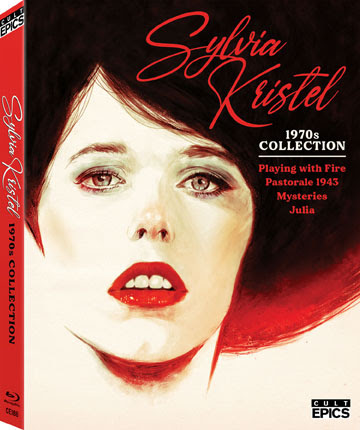Review—Sylvia Kristel: 1970s Collection (Cult Epics)
Author: Palo Sionoplia
Films: Playing with Fire, Pastorale 1943, Mysteries, Julia
Cult Epics knows its audience, as evidenced by the boutique label’s more thirty years of success in the home video marketplace. Founded in Amsterdam, the label has always remained loyal to its Dutch origins, and the Kristel 1970s Collection, released as a numbered, limited edition box set, is arguably the label’s most on-brand release to date.
While produced with care, this curated collection is obviously a rather niche affair, particularly because it features Kristel in films that will largely be unknown to North American audiences. In two of the set’s four films, the famed Emmanuelle star appears in small supporting roles. The experience will vary, depending on the interests in the viewer. One might walk away disappointed by the content’s obscurity and Kristel’s lack of screentime in 50% of this collection; on the contrary, a viewer might enjoy the opportunity to see Kristel in a set of intriguing and seldom-screened films. In either case, Cult Epics delivers a unique product. The bulk of these films would likely remain unknown to American viewers, if not for the advent of this collection.
The first film in the set, Playing with Fire, is esoteric not just for Kristel but for the movie’s director, Alain Robbe-Grillet. Arguably the least-viewed film in the director’s oeuvre, the meta-caper about a kidnapping ring is far more invested in set pieces than plot. (At one point, the story’s ostensible ‘hero’ faces the camera and admits that “the script didn’t make any sense.”). Firmly rooted in the avant-garde, Playing with Fire marks Kristel’s first involvement with experimental film, and, despite her dozen minutes of screentime, she makes the most of the opportunity.
Pastorale 1943 is the set’s most conventional film, a two-hour war drama about Dutch resistance to Nazi occupation. It’s a well-constructed meditation on civilian life during wartime, though Kristel, regrettably, appears in only a handful of short scenes. While she plays a pivotal character, her brief appearance in the film plays more like a grab for funding and international attention. Similarly, the inimitable Rutger Hauer appears during the last four minutes—a wasted opportunity indeed.
Thankfully, these problems are corrected in the collection’s third film, Mysteries, another Dutch production that puts Kristel and Hauer at the center of the narrative. A period piece set in the late nineteenth century, Kristel plays an arguably callous and provincial aristocrat, while Hauer’s character is sensitive, tortured, and possibly insane. Keeping up with Hauer in scene after scene is no easy task for any actor, and Mysteries demonstrates Kristel’s acting chops, pushing back against her typical representation as a pinup girl. Furthermore, Mysteries features cult favorite David Rappaport—best known as the leader of a band of misfit thieves in Terry Gilliam’s Time Bandits—in his first starring film role. By far the finest film in the set, Mysteries will be of considerable interest to Kristel, Hauer, and Rappaport fans alike.
Julia, the final film in the collection, is a largely plotless German sex comedy. This is the sort of fare that American audiences most likely associate with Kristel, and I suppose that’s not a compliment. The film, despite a few genuinely funny moments, is a largely dull affair, replete with flat characters and senseless plot twists. (The male lead’s attempted sexual assault is somehow forgotten entirely within ten minutes, and another character’s accidental drowning similarly fades into the background without consequence.) Despite its brief running time, you may find yourself looking at your watch during this one.
The transfers of these films range from impressive (Playing with Fire) to problematic (Pastorale 1943). Sadly, the set’s strongest film, Mysteries, suffers from heavy print damage, and exterior shots often appear washed out. I expect that Cult Epics has done the best possible work with the less-than-pristine elements, and, despite the problems with the color palette and occasional imbalances in the audio tracks, the films remain watchable.
Extras are somewhat sparse but uniformly interesting. Here’s a breakdown of what you’ll find on each disc. (Note that the same trailers for Mysteries, Pastorale 1943, and Julia are repeated on each disc. A trailer for Playing with Fire is absent from the collection.)
Playing with Fire: Feature audio commentary by Tim Lucas; Interview with Catherine Robbe-Grillet (5 minutes); Mysteries trailer; Pastorale 1943 trailer; Julia trailer; Poster and stills gallery
Julia: Feature audio commentary by Jeremy Richey; poster and lobby card gallery; Julia trailer; Mysteries trailer; Pastorale 1943 trailer
Mysteries: Feature audio commentary by Peter W. Verstraten; Feature audio commentary by Jeremy Richey; Interview with the cast and director (6 minutes); Poster and photo gallery; Mysteries trailer; Pastorale 1943 trailer; Julia trailer
Pastorale 1943: Feature audio commentary by Peter W. Verstraten; Interview with Sylvia Kristel and Frederik de Groot (7 minutes); Interview with Sylvia Kristel (11 minutes); Poster and photo gallery; Pastorale 1943 Promo (1 minute); Pastorale 1943 trailer; Mysteries trailer; Julia trailer
Additionally, the set includes a 40-page squarebound booklet featuring excerpts Jeremy Richey’s Sylvia Kristel: From Emmanuelle to Chabrol.
The Verstraten commentaries are particularly informative, and Kristel’s 11-minute interview (included on the Pastorale 1943 disc) is fascinating, as she explains the problem of working with pampered male egotists like Rex Harrison, men who would dismiss her out of hand as a performer who brought in money at the box office but would not stand the test of time. The Kristel collection demonstrates the wrongness of that presumption, and that is reason enough for its inclusion on your shelf.

